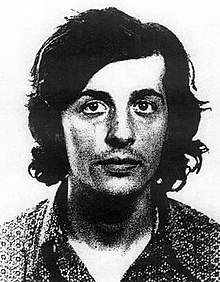Salvador Puig Antich
Salvador Puig Antich (Catalan pronunciation: [səlβə'ðo ˈpudʒ‿ənˈtik]; 1948–1974) was a Catalan militant anarchist whose execution under Francoist Spain made him a cause célèbre for Catalan autonomists, pro-independence supporters, and anarchists. After fighting the Spanish State with the terrorist group Iberian Liberation Movement in the early 1970s, he was convicted and executed by garrote vil for the death of a policeman during a shoot out.
Salvador Puig Antich | |
|---|---|
 Undated photo of Salvador Puig Antich | |
| Born | May 30, 1948 |
| Status | Executed by garrote vil |
| Died | March 2, 1974 (aged 25) Barcelona, Spain |
Catalonians viewed Puig Antich's judicial death as symbolic retribution for the region's fight for self-government, and his name became commonplace in Barcelona. The incident inspired works by Catalan artists Joan Miró and Antoni Tàpies, and a satirical play by the Catalan theater group Els Joglars. The 2006 film Salvador depicts Puig Antich's time on death row. After the Spanish Supreme Court declined an effort to review the execution, an Argentine court adopted the case under universal jurisdiction in 2013.
Iberian Liberation Movement
Salvador Puig Antich was born May 30, 1948, in Barcelona, Spain. He was a member of the Workers' Commissions before he joined the Iberian Liberation Movement (Movimiento Ibérico de Liberación, or MIL). The group organized armed robberies against banks, which they called "expropriations", allegedly to fund their actions against Francoist Spain in 1972 and 1973. After a series of these robberies, he was arrested for the death of a policeman during a shoot out. A military court sentenced him to death by garrote vil in the Model prison.[1] His execution proceeded despite international outcry,[2][3][4] as Spain's second state execution in eight years.[4] University students in Barcelona and Madrid went on strike in protest of the execution, whereupon they fought with police.[5]
Legacy
Catalonians interpreted Puig Antich's execution as symbolic retaliation for the region's fight for autonomy, which led to public demonstrations.[4] As one of Franco's last victims, Puig Antich became a household name in Barcelona.[6] The Groupes d'action révolutionnaire internationalistes (GARI) formed to avenge his death.[7]
Several years after his 1974 execution, the Catalan performance group Els Joglars performed La torna, a 1977 satire against torture based on Puig Antich's execution. Even though Francoist Spain had ended, along with its censorship laws, members of Els Joglars were jailed or forced into exile. Spanish theater groups protested across Spain.[8] Catalan painters Joan Miró and Antoni Tàpies both alluded to Puig Antich's execution in their mid-1970s work.[9][10] Miró's The Hope of a Condemned Man triptych features a line that "sighs and falls with faltering resignation" and flicked paint.[9] Tàpies's Assassins lithograph series, presented at the Parisian Galerie Maeght, too was inspired by Puig Antich's execution and Spanish politics.[10] The 2006 film Salvador depicts Puig Antich's time spent on death row.[11]
An effort by family members and outside groups to review Puig Antich's case was rejected by the Spanish Supreme Court in 2007, but an Argentine judge adopted the case with those of other Francoist victims under universal jurisdiction in 2013.[1]
Puig Antich is interred in the Montjuïc Cemetery in Barcelona.
References
- "Salvador Puig i Antich". Gran enciclopèdia catalana. Enciclopèdia Catalana. January 24, 2014. Retrieved August 8, 2017.
- Hensbergen, Gijs van (2013). Guernica: The Biography of a Twentieth-Century Icon. A&C Black. p. 285. ISBN 978-1-4088-4148-8.
- Anaya, Pilar Ortuño (2001). European Socialists and Spain: The Transition to Democracy, 1959-77. Palgrave Macmillan. p. 67. ISBN 978-1-4039-0701-1.
- Payne, Stanley G. (2011). The Franco Regime, 1936–1975. University of Wisconsin Pres. p. 596. ISBN 978-0-299-11073-4.
- "News Summary and Index". The New York Times. March 5, 1974. ISSN 0362-4331.
- Connolly, Tristanne (2011). Spectacular Death: Interdisciplinary Perspectives on Mortality and (Un)Representability. Intellect Books. p. 144. ISBN 978-1-84150-322-6.
- Gildea, Robert; Mark, James; Warring, Anette (2013). Europe's 1968: Voices of Revolt. OUP Oxford. p. 275. ISBN 978-0-19-165127-4.
- George, David (2002). "Els Joglars". In Rodgers, Eamonn (ed.). Encyclopedia of Contemporary Spanish Culture. Routledge. pp. 277–278. ISBN 978-1-134-78859-0.
- Searle, Adrian (April 11, 2011). "Joan Miró: A fine line". The Guardian. ISSN 0261-3077.
- Dávila, Mela; Tàpies, Antoni (2004). Tàpies, in perspective. Barcelona: Actar. p. 477. ISBN 978-84-95951-56-4.
- Weissberg, Jay (May 23, 2006). "Review: 'Salvador'". Variety. Retrieved August 8, 2017.
Further reading
- Bravo, Gutmaro Gómez (March 2, 2014). "40 años bajo secreto". EL PAÍS. Retrieved August 8, 2017.
- Congostrina, Alfonso L. (March 3, 2017). "Barcelona se querellará contra el militar que firmó la pena de muerte de Puig Antich". EL PAÍS. Retrieved August 8, 2017.
- Congostrina, Alfonso L. (June 8, 2017). "El dolor de las hermanas de Salvador Puig Antich". EL PAÍS. Retrieved August 8, 2017.
- Junquera, Natalia (January 19, 2015). "Historia inacabada de Puig Antich". EL PAÍS. Retrieved August 8, 2017.
- Meltzer, Albert (1996). "The Execution of Puig Antich". I couldn't paint golden angels: sixty years of commonplace life and anarchist agitation. San Francisco: AK Press. ISBN 978-1-873176-93-1.
External links
- Articles about Salvador Puig Antich from the Kate Sharpley Library
- Papers at the Pavelló de la República CRAI Library